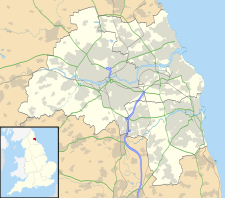St Nicholas Hospital, Newcastle upon Tyne
| St Nicholas Hospital | |
|---|---|
| Cumbria, Northumberland, Tyne and Wear NHS Foundation Trust | |
 St Nicholas Hospital | |
| Geography | |
| Location | Gosforth, Newcastle upon Tyne, England, United Kingdom |
| Coordinates | 55°00′23″N 1°38′05″W / 55.006344°N 1.634747°W |
| Organisation | |
| Care system | NHS England |
| Type | Psychiatric hospital |
| History | |
| Opened | 1864 |
| Links | |
| Website | www |
| Lists | Hospitals in England |
St Nicholas Hospital is an NHS psychiatric hospital located in Gosforth, Newcastle upon Tyne, England, UK. The entrance is located on Jubilee Road. The buildings range from Victorian-era to modern facilities and occupy 12 hectares (30 acres) of land.[1] The hospital is managed by Cumbria, Northumberland, Tyne and Wear NHS Foundation Trust.
History
[edit]Early history
[edit]As Newcastle upon Tyne did not have a hospital of its own for mentally ill patients,[2] a new asylum was proposed in Coxlodge, where a 50-acre (20 ha) farmstead known as Dodd's Farm[3] was purchased. In 1864 initial plans were drawn up, and William Lambie Moffatt was appointed architect.[4] The facility opened as Newcastle upon Tyne Borough Lunatic Asylum in July 1869 and became the Newcastle upon Tyne City Lunatic Asylum in 1882.[5] Some of the first patients were transferred from Bensham Asylum as Durham County Magistrates had refused to renew the contract of that facility.[6]
In 1884 permission was granted to extend the hospital, and the East and West Pavilions were completed in 1887. These allowed an additional 80 patients to be admitted.[7] The asylum steadily grew, with more buildings erected. During the First World War the patients were evacuated and the hospital became Northumberland No. 1 War Hospital for wounded soldiers, who were brought there by train. The facility reverted to an asylum in 1921.[8] In 1948 the National Health Service took over the hospital and changed the name to St Nicholas Hospital.[5]
A new admissions unit called the Collingwood Clinic was opened in 1956.[9] The site of the former Collingwood Clinic was sold in the 1990s and is now used by Virgin Money.[10] Part of the original asylum was sold in the late 1990s and converted into housing, now known as Lanesborough Court.[10]
In 1986 a church that had been located within the hospital grounds burned down.[11] The area used by the church is now occupied by the 1994-built Ashgrove Nursing Home.[11]
Recent history
[edit]Work to build an extension, the Bamburgh Clinic, on the site of a former fish factory,[12] at a cost of £22 million started in November 2004 and was completed in April 2006.[13] The new clinic is bordered by residential properties and a Northumberland Wildlife Trust wildlife centre and office.[14]
In 2009 the Greentrees unit and the Lennox Ward were renovated at a cost of circa £8 million. The renovation of these Victorian hospital buildings was one of eight projects short-listed from 20 entries for the Best Design in the Community Benefit category of the Royal Institution of Chartered Surveyors North-East Renaissance Awards.[15]
Jubilee Theatre
[edit]The hospital also includes the Jubilee Theatre, a theatre which opened in 1899.[16] Currently the theatre is primarily used by two groups: Juniper Productions (founded 1998) a drama group for sufferers of mental health difficulties, and since 1992, an external theatre company, First Act Theatre.[16]
Bibliography
[edit]- Ewing, Logan (2009). A History of St. Nicholas Hospital, Newcastle-upon-Tyne, England 1869-2001. AuthorHouse. ISBN 978-1438937540.
See also
[edit]References
[edit]- ^ "Northumberland, Tyne and Wear NHS Foundation Trust - Our Sites and Directions". 24 December 2013. Archived from the original on 24 December 2013. Retrieved 17 August 2021.
- ^ "St Nicholas". County Asylums. Retrieved 14 October 2018.
- ^ "Gosforth, St. Nicholas Hospital Conservation Area". Twsitelines.info. Retrieved 10 February 2019.
- ^ "Newcastle Asylum". Dictionary of Scottish Architects. Retrieved 14 December 2008.
- ^ a b Reference number HO.SN. Tyne and Wear Archives Service.
- ^ "Gosforth, High Coxlodge/Asylum Farm | sitelines.newcastle.gov.uk". Twsitelines.info. Retrieved 23 September 2018.
- ^ "St Nicholas Hospital, Gosforth | The National Archives". Discovery.nationalarchives.gov.uk. Retrieved 23 September 2018.
- ^ "World War One At Home, St Nicholas Hospital, Gosforth: From Asylum to War Hospital". BBC. 6 November 2014. Retrieved 26 May 2018.
- ^ "Tyne and Wear Archives Service Catalogue". 22 October 2015. Archived from the original on 22 October 2015. Retrieved 17 August 2021.
- ^ a b "St. Nicholas". County Asylums. 14 July 2020. Retrieved 23 July 2023.
- ^ a b "St. Nicholas Hospital Conservation Area Character Statement" (PDF). Newcastle City Council. April 2005. Retrieved 21 August 2021.
- ^ "Case Studies - Bamburgh Clinic, St Nicholas Hospital, Newcastle". Royal Institute of British Architects. Archived from the original on 13 July 2014. Retrieved 23 October 2014.
{{cite web}}: CS1 maint: bot: original URL status unknown (link) - ^ "Shine - Bamburgh Clinic, St Nicholas Hospital, Newcastle Detailed case study" (PDF). 19 April 2009. Archived (PDF) from the original on 19 April 2009. Retrieved 17 August 2021.
- ^ "About". Northumberland Wildlife Trust. Archived from the original on 8 February 2007. Retrieved 14 December 2008.
{{cite web}}: CS1 maint: unfit URL (link) - ^ "Hospital in the running". 2 April 2009. Archived from the original on 4 April 2009. Retrieved 2 April 2009.
{{cite web}}: CS1 maint: bot: original URL status unknown (link). The Northern Echo, 2 April 2009 - ^ a b "Jubilee Theatre". First Act Theatre. Archived from the original on 27 September 2007. Retrieved 23 October 2014.


